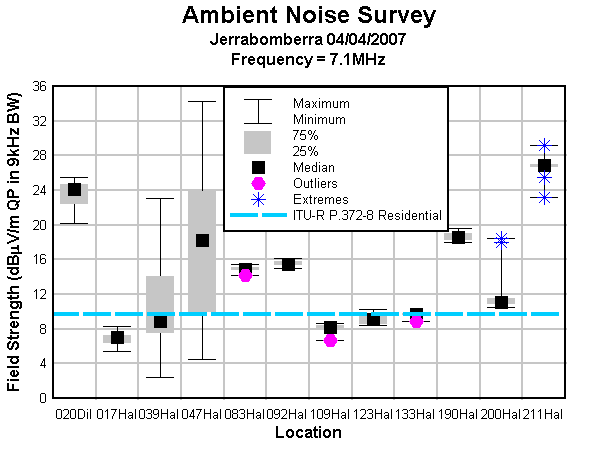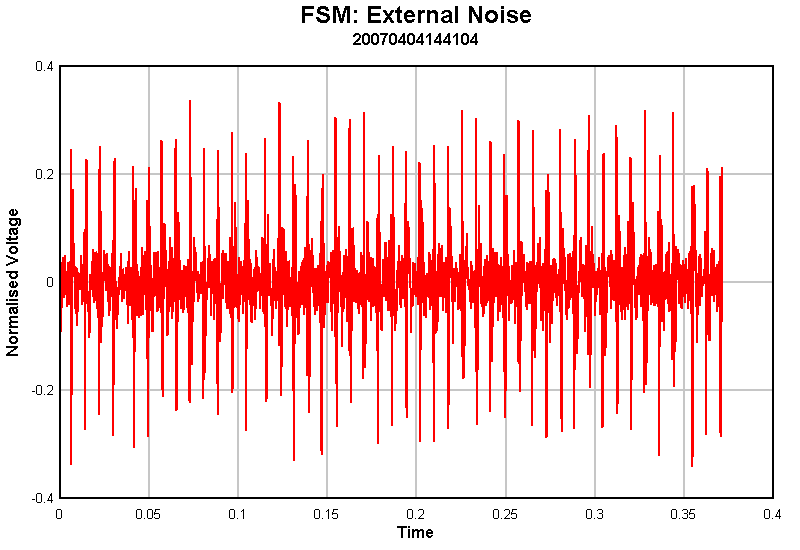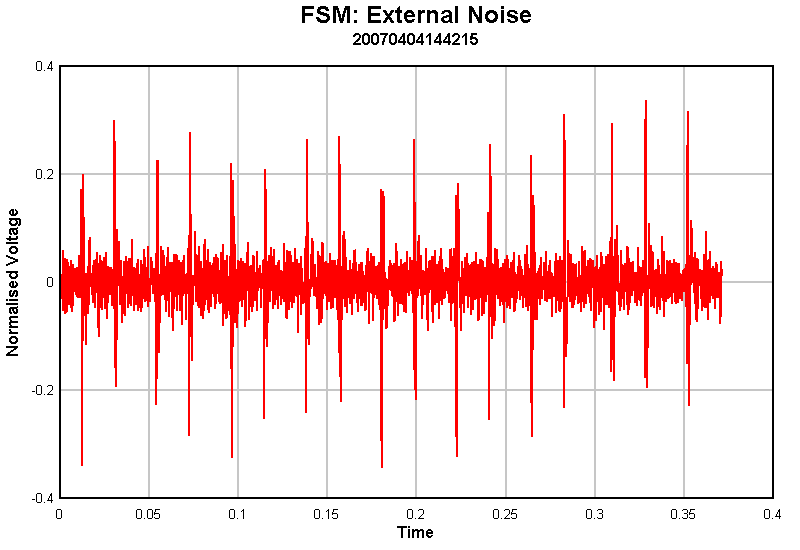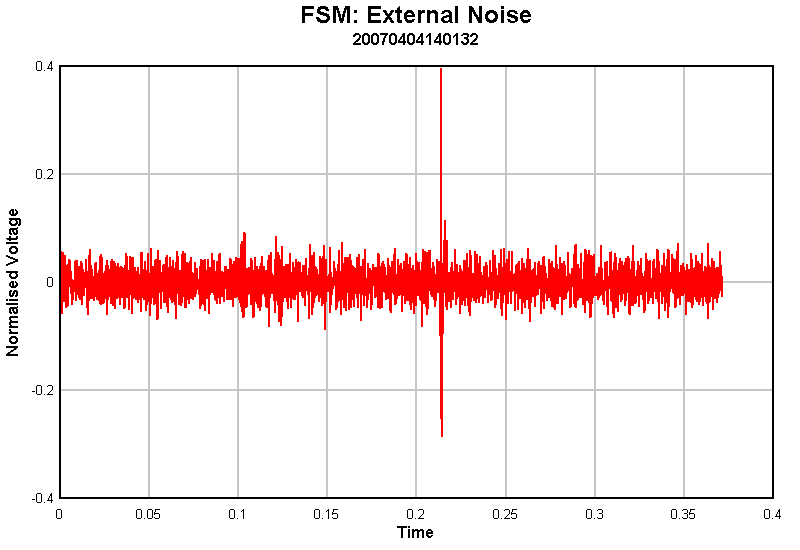Observations of ambient noise / emissions at Jerrabomberra - April 2007
| This is a report on ambient noise / emission observations at Jerrabomberra on 4 April 2007. |
Overview
This article documents a small survey of ambient noise / emissions at 7.1MHz in a number of sites in Jerrabomberra residential environment. Jerrabomberra is low density residential land use and uses underground power reticulation, street lighting uses galvanised steel poles with gas discharge luminaires. The time of observation was between 14:00 and 15:00 on a weekday when many or most of the residents would be absent at work.
Field strength measurements made with FSM, an IC7000 Transceiver, HP355D attenuator and a MobileOne M40 helical whip. Measurements were normalised to 1Hz bandwidth within FSM, and the chart below extrapolates the field strength to 9kHz. Weather was fine, some cloud, and low level to moderate atmospheric noise from storm activity was evident at 7MHz.
Measurements were made on a clear 2kHz wide channel as close as practicable to 7.1MHz at twelve sites from a vehicle parked at the roadside. Ten measurements were made at most sites and more at two sites affected by impulse noise, so there are 146 measurements spread over twelve locations.
Antenna details and calibration assumptions are at http://www.vk1od.net/m40/index.htm .
The FSM data records of the observations is available for download in the Excel spreadsheet of observations.
Analysis
Measurements were made at locations chosen at random along Halloran Street, and one additional site in Dilwynnia Street in the proximity of a sub station that appeared to be BPL enabled.
 |
Fig 1 shows the distribution of measured quasi peak field strength at the twelve locations. Four of the locations were affected by BPL or impulse emissions that would not normally be heard in a residential area, see Table 1 for observation notes. Five of the remaining sites showed median noise levels within 3dB of ITU-R P.372-8 Residential levels, and the other three were 5dB to 8dB above ITU-R P.372-8 Residential levels. It was clear from a drive test along Halloran Street that there were occasional local noise maxima, where noise level was elevated over 30m to 60m of road length suggesting that the noise source is probably a single residence. Possible noise sources would include inverter air conditioners, television screens and switched mode power supplies (eg computers).
| Location | Median noise wrt ITU-R P.372-8 Residential level (dB) | Observation notes |
| 20 Dilwynnia | 14.4 | Affected by BPL, 60m from sub station 3311 |
| 17 Halloran | -2.7 | |
| 39 Halloran | -0.9 | Affected by impulse noise at about 1Hz rate |
| 47 Halloran | 8.5 | Affected by impulse noise at about 1Hz rate |
| 83 Halloran | 5.2 | Distinct local noise maximum |
| 92 Halloran | 5.8 | Distinct local noise maximum |
| 109 Halloran | -1.6 | |
| 123 Halloran | -0.6 | |
| 133 Halloran | 0.0 | |
| 190 Halloran | 8.8 | Distinct local noise maximum |
| 200 Halloran | 1.3 | |
| 211 Halloran | 17.2 | Affected by BPL, 10m from sub station 3311 |
BPL emissions at 211 Halloran and 20 Dilwynnia streets
Emissions characteristic of BPL were observed in one area of Halloran Street.
 |
Fig 2 shows a plot of the receiver audio output near the sub station 3311. This sample was from a short periodic pattern of high pulse repetition rate.
 |
Fig 3 shows a plot of the receiver audio output near the sub station 3311. This sample was characteristic of the signal at times other than signal depicted in Fig 2. A mp3 sound file that gives an indication of the sound of this emission was created by repeating this sample to fill a 5s duration file which can be played here. Note that this system appeared to have very low traffic, so the sound may change when carrying a higher traffic level.
The impact of the emission field strength observed at 211 Halloran Street on an 7MHz amateur radio station with a half wave dipole antenna would be a received signal level of S9+5dB which would effectively prevent all operations on the band. In reality, a dipole erected on a nearby property might be subject to higher field strength than experienced near the sub station which is shielded to some extent by its metal enclosure. Factors like building materials (eg roof material, use of wall and roof sarking etc) will have bearing on the radiation from house wiring. Only experience will tell!
Radiation levels were much lower than observed and documented in other Queanbeyan trials which could be the result of lower operating power, notching of certain frequency bands, underground reticulation, and possibly other factors. The emissions that were observed near the substation at up to 20dB above expected ambient would be an issue for an amateur station located at a nearby property.
Impulse noise at 39 and 47 Halloran
A high level periodic impulse was experienced in measurements at 39 and 47 Halloran Street. The impulse repetition period is estimated at about 1 second.
 |
Fig 4 is a plot of the receiver audio output including one of the impulses. Whilst there were not other characteristic signs of BPL, a ticking sound at about 1Hz rate has often been observed of BPL systems, and this impulse may be an artefact of a BPL system that is not passing traffic on the measurement channel. The impulse could be heard over about 300m of road length, with several distinct peaks in strength, suggesting that it was probably a relatively local source.
Conclusion
A Broadband over Power Lines (BPL) installation is operating in at least one precinct in Jerrabomberra.
The BPL installation does radiate electromagnetic energy and the observed radiated signal level is much higher in intensity than the background noise level in places.
The measured emission levels at 7MHz would be extremely disruptive of radio communications.
Links
Glossary
| Term | Meaning |
| BPL | Broadband over Power Lines, a technique for high speed data transmission over power infrastructure |
| HV | High Voltage |
| Interference | From the Radiocommunications Act 1992 (Cth), interference means: (a) in relation to radiocommunications - interference to, or with, radiocommunications that is attributable, whether wholly or partly and whether directly or indirectly, to an emission of electromagnetic energy by a device; or (b) in relation to the uses or functions of devices-interference to, or with, those uses or functions that is attributable, whether wholly or partly and whether directly or indirectly, to an emission of electromagnetic energy by a device. |
| LV | Low Voltage |
| PLC | Power Line Communications |
| PLT | Power Line Telecommunications |
Disclaimer
Use at your own risk, not warranted for any purpose. Do not depend on any results without independent verification.
V1.01. Last changed: 20 February 2009 19:24